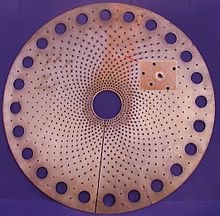Advice please;
I’m wanting to build a bitter plate electromagnet. Essentially this means many (read: hundreds) of layers of foil with an insulating layer between.
An example of a complex pattern;


The holes allow coolant, and structural support. The thin layers allow many “turns” and the width allows high currents.
Also, it’s interesting.
I’ve thought of a couple of ways;
- Etching from template
- placing insulator on one side, foil on the other, with toner transfer or similar resist
- pros; known technique
- cons; doesn’t cut the insulator, limited throughput, difficult etching through aluminium oxide, dangerous heat
- CnC milling
- milling a composite of insulator and aluminium foils, or a stack thereof
- pros; semi-automated, faster than etching, cuts foil and insulator
-cons; may be single layer at a time; tool head likely to rip foil; ? Feasibility on space hardware
- Plasma via CnC
- making a simple X/Y stage CnC, and using the tried-and-true graphite pencil with 9v battery stack
- pros; achievable machine build, interesting, able to cut foil
- cons; not able to cut insulator, spark hazard, special machine build
- EDM via CnC
- pros; interesting machine build, able to cut foil
- cons; not able to cut insulator, higher degree of difficulty and voltage, spark hazard, special machine build
Truly experimental;
5) Lasercutting foil via matte-coat spraypaint
- similar to Lasercutting traces in PCB blanks; spraypaint the foil, etch the spray and hope it takes the foil with it
- pros; existing machine, minimal extra work (spray can also be insulator?)
- cons; untried (although done with PCBs as above), access to cutter, limited throughput
- Press and die
- pros; once made, reusable, simple mechanically, able to leverage existing equipment
- cons; making said die, manually pressing each piece, needs to be harder than aluminium foil (I.e machined steel?
I’d appreciate thoughts
Cheers,
Lauren